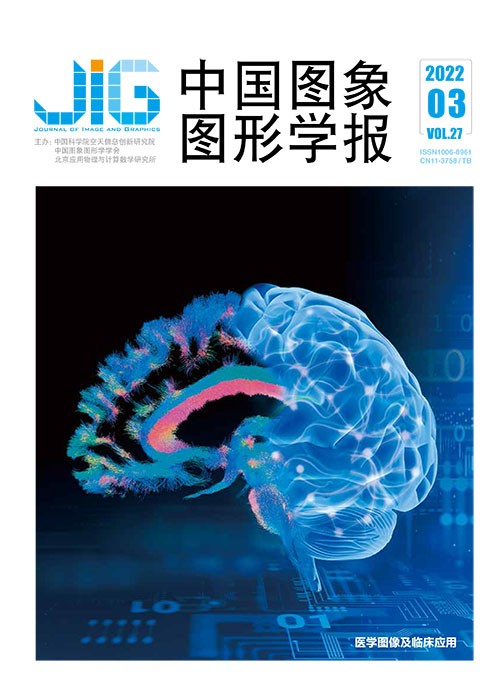
结合注意力机制的乳腺双模态超声分类网络
摘 要
目的 影像学医师通常通过观察乳腺B型超声(brightness-mode ultrasound)肿瘤区域进行良恶性分析,针对难以辨别的病例则融合其对应的超声造影(contrast-enhanced ultrasound,CEUS)特征进一步判别。由于超声图像灰度值范围变化小、良恶性表现重叠,特征提取模型如果不能关注到病灶区域将导致分类错误。为增强网络模型对重点区域的分析,本文提出一种基于病灶区域引导的注意力机制,同时融合双模态数据,实现乳腺超声良恶性的精准判别。方法 通过对比实验,选取一个适合超声图像特征提取的主干分类模型ResNet34;为学习到更有分类意义的特征,以分割结节的掩膜图(region of interest,ROI-mask)作为引导注意力来修正浅层空间特征;将具有分类意义的超声造影各项评价特征向量化,与网络提取的深层特征进行融合分类。结果 首先构建一个从医院收集的真实病例的乳腺超声数据集BM-Breast (breast ultrasound images dataset),与常见分类框架ResNet、Inception等进行对比实验,并与相关最新乳腺分类研究成果对比,结果显示本文设计的算法在各项指标上都有较大优势。本文提出的融合算法的分类准确性为87.45%,AUC (area under curve)为0.905。为了评估对注意力引导机制算法设计的结果,在本文实验数据集和公开数据集上分别进行实验,精度相比对比算法提升了3%,表明本文算法具有较好的泛化能力。实验结果表明,融合两种模态超声数据的特征可以提升最终分类精度。结论 本文提出的注意力引导模型能够针对乳腺超声成像特点学习到可鉴别的分类特征,双模态数据特征融合诊断方法进一步提升了模型的分类能力。高特异性指标表现出模型对噪声样本的鲁棒性,能够较为准确地辨别出难以判别的病例,本文算法具有较高的临床指导价值。
关键词
Attention-based networks of human breast bimodal ultrasound imaging classification
Zhao Xu1, Gong Xun1, Fan Lin1, Luo Jun2(1.School of Computing and Artificial Intelligence, Southwest Jiaotong University, Chengdu 610031, China;2.Department of Ultrasound, Sichuan Academy of Medical Sciences, Sichuan Provincial People's Hospital, Chengdu 610072, China) Abstract
Objective Brightness-mode ultra-sound images are usually generated from the interface back to the probe by the echo of sound waves amongst different tissues. This method has its priority for no ionizing radiation and low price. It has been recognized as one of the most regular medical imaging by clinicians and radiologists. Imaging physicians usually diagnose tumors via breast ultrasound tumor regions observation. These features are fused with the corresponding contrast-enhanced ultrasound features to enhance visual information for further discrimination. Therefore, the lesion area can provide effective information for discriminating the shape and boundary. Machine learning, especially deep learning, can learn the middle-level and high-level abstract features from the original ultrasound, generating several applicable methods and playing an important role in the clinic, such as auxiliary diagnosis and image-guided treatment. Currently, it is widely used in tumor diagnosis, organ segmentation, and region of interest (ROI) detection and tracking. Due to the constrained information originated from B-model ultrasound and its overlapping phenomenon, the neural network cannot focus on the lesion area of the image with poor imaging quality during the feature extraction, resulting in classification errors. Therefore, in order to improve the accuracy of human breast ultrasound diagnosis, this research illustrates an end-to-end automatic benign and malignant classification model fused with bimodal data to realize an accurate diagnosis of human breast ultrasound. Method First, a backbone networks, of ResNet34 is optioned based on experimental comparison. It can learn more clear features for classification, especially for breast ultrasound images with poor imaging effects. Hence, the ultrasound tumor segmentation mask is as a guide to strengthening the learning of the key features of classification based on the residual block. The model can concentrate on the targeting regions via reducing the interference of tumor overlapping phenomenon and lowering the influence of poor image quality. An attention guidance mechanism is facilitated to enhance key features, but the presence of noise samples in the sample, such as benign tumors exhibiting irregular morphology, edge burrs, and other malignant tumor features, will reduce the accuracy of model classification. The contrast-enhanced ultrasound morphological features can be used to distinguish the pathological results of tumors further. Therefore, we use the natural language analysis method to convert the text of the pathological results into a feature vector based on the effective contrast-enhanced ultrasound (CEUS) pathological notations simultaneously, our research analysis visualizes the spatial distribution of the converted vectors to verify the usability of the pathological results of CEUS in breast tumors classification. It is sorted out that the features are distributed in clusters and polarities, which demonstrates the effectiveness of the contrast features for classification. At the end, our research B-mode ultrasound extraction of deep image features fuses various feature vectors of CEUS to realize the classification of breast tumors. Result The adopted breast ultrasound images dataset(BM-Breast) dataset is of 1 093 breast ultrasound samples that have been desensitized and preprocessed (benign:malignant=562:531). To verify the algorithm's effectiveness, this paper uses several mainstream classification algorithms for comparison and compared them with the classification accuracy of algorithms for breast ultrasound classification. The classification accuracy of the proposed fusion algorithm reaches 87.45%, and the area under curve (AUC) reaches 0.905. In the attention guidance mechanism module, this paper also conduct experiments on both a public dataset and a private dataset. The experimental results on those two datasets show that the classification accuracy has been improved by 3%, so the algorithm application is effective and robust. Conclusion Our guided attention model demonstration can learn the effective features of breast ultrasound. The fusion diagnosis of bimodal data features improves the diagnosis accuracy. This algorithm analysis promotes cooperation further between medicine and engineering via the clinical diagnosis restoration. The illustrated specificity facilitates the model capability to recognize noise samples. More accurately distinguish cases that are difficult to distinguish in clinical diagnosis. The experimental results show that the classification model algorithm in this paper has practical value.
Keywords
attention mechanism feature fusion and classification breast ultrasound bimodal data intelligent diagnosis
|



 中国图象图形学报 │ 京ICP备05080539号-4 │ 本系统由
中国图象图形学报 │ 京ICP备05080539号-4 │ 本系统由